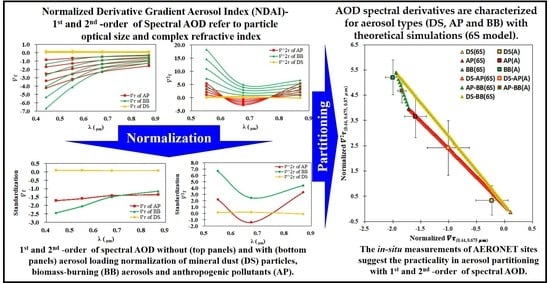Spectral Derivatives of Optical Depth for Partitioning Aerosol Type and Loading
Abstract
1. Introduction
2. Methodology
2.1. Experiment of Theoretical Simulation
2.2. Spectral Derivatives of AOD
2.3. AOD Partitioning in Aerosol Mixtures
3. Measurements
4. Results and Analysis
4.1. Theoretical Spectral AOD Derivatives
4.2. Measurements for Spectral AOD Derivatives
4.3. Verification of AOD Fraction from NDAI
4.4. Validation of Aerosol Type with In-Situ Measurement
5. Discussion
6. Conclusions and Future Work
Supplementary Materials
Author Contributions
Funding
Institutional Review Board Statement
Informed Consent Statement
Data Availability Statement
Acknowledgments
Conflicts of Interest
References
- Myhre, G.; Shindell, D.; Bréon, F.; Collins, W.; Fuglestvedt, J.; Huang, J.; Koch, D.; Lamarque, J.; Lee, D.; Mendoza, B.; et al. Anthropogenic and natural radiative forcing. In Climate Change 2013: The Physical Science Basis. Contribution of Working Group I to the Fifth Assessment Report of the Intergovernmental Panel on Climate Change, 5th ed.; Stocker, T.F., Qin, D., Plattner, G.-K., Tignor, M., Allen, S.K., Boschung, J., Nauels, A., Xia, Y., Bex, V., Midgley, P.M., Eds.; Cambridge University Press: Cambridge, UK; New York, NY, USA, 2013; pp. 659–740. [Google Scholar]
- Haywood, J.; Shine, K. The effect of anthropogenic sulfate and soot aerosol on the clear sky planetary radiation budget. Geophys. Res. Lett. 1995, 22, 603–606. [Google Scholar] [CrossRef]
- Feng, N.; Christopher, S.A. Clear sky direct radiative effects of aerosols over Southeast Asia based on satellite observations and radiative transfer calculations. Remote Sens. Environ. 2014, 152, 333–344. [Google Scholar] [CrossRef]
- Lin, T.-H.; Yang, P.; Yi, B. Effect of black carbon on dust property retrievals from satellite observations. J. Appl. Remote Sens. 2013, 7, 073568. [Google Scholar] [CrossRef][Green Version]
- Kahn, R.A.; Gaitley, B.J. An analysis of global aerosol type as retrieved by MISR. J. Geophys. Res. Atmos. 2015, 120, 4248–4281. [Google Scholar] [CrossRef]
- Chang, K.-E.; Hsiao, T.-C.; Hsu, N.-Y.; Wang, S.-H.; Lin, N.-H.; Liu, G.-R.; Liu, C.; Lin, T. Mixing weight determination for retrieving optical property of polluted dust with MODIS and AERONET data. Environ. Res. Lett. 2016, 11, 085002. [Google Scholar] [CrossRef]
- Kim, J.; Lee, J.; Lee, H.C.; Higurashi, A.; Takemura, T.; Song, C.H. Consistency of the aerosol type classification from satellite remote sensing during the Atmospheric Brown Cloud–East Asia Regional Experiment campaign. J. Geophys. Res. Atmos. 2007, 112, D22S33. [Google Scholar] [CrossRef]
- Lee, J.; Kim, J.; Song, C.; Kim, S.; Chun, Y.; Sohn, B.; Holben, B. Characteristics of aerosol types from AERONET sunphotometer measurements. Atmos. Environ. 2010, 44, 3110–3117. [Google Scholar] [CrossRef]
- Eck, T.F.; Holben, B.N.; Sinyuk, A.; Pinker, R.T.; Goloub, P.; Chen, H.; Chatenet, B.; Li, Z.; Singh, R.P.; Tripathi, S.N.; et al. Climatological aspects of the optical properties of fine/coarse mode aerosol mixtures. J. Geophys. Res. 2010, 115, D19205. [Google Scholar] [CrossRef]
- Barnaba, F.; Gobbi, G. Aerosol seasonal variability over the Mediterranean region and relative impact of maritime, continental and Saharan dust particles over the basin from MODIS data in the year 2001. Atmos. Chem. Phys. 2004, 4, 2367–2391. [Google Scholar] [CrossRef]
- Higurashi, A.; Nakajima, T. Detection of aerosol types over the East China Sea near Japan from four-channel satellite data. Geophys. Res. Lett. 2002, 29, 17-1–17-4. [Google Scholar] [CrossRef]
- Kaufman, Y.; Boucher, O.; Tanré, D.; Chin, M.; Remer, L.; Takemura, T. Aerosol anthropogenic component estimated from satellite data. Geophys. Res. Lett. 2005, 32, L17804. [Google Scholar] [CrossRef]
- Kaskaoutis, D.; Kosmopoulos, P.; Kambezidis, H.; Nastos, P. Aerosol climatology and discrimination of different types over Athens, Greece, based on MODIS data. Atmos. Environ. 2007, 41, 7315–7329. [Google Scholar] [CrossRef]
- King, M.D.; Kaufman, Y.J.; Tanré, D.; Nakajima, T. Remote sensing of tropospheric aerosols from space: Past, present, and future. Bull. Am. Meteorol. Soc. 1999, 80, 2229–2259. [Google Scholar] [CrossRef]
- Ingmann, P.; Veihelmann, B.; Langen, J.; Lamarre, D.; Stark, H.; Courreges-Lacoste, G.B. Requirements for the GMES Atmosphere Service and ESA’s implementation concept: Sentinels-4/-5 and -5p. Remote Sens. Environ. 2012, 120, 58–69. [Google Scholar] [CrossRef]
- Tsay, S.-C.; Maring, H.B.; Lin, N.-H.; Buntoung, S.; Chantara, S.; Chuang, H.-C.; Gabriel, P.M.; Goodloe, C.S.; Holben, B.N.; Hsiao, T.; et al. Satellite-surface perspectives of air quality and aerosol-cloud effects on the environment: An overview of 7-SEAS/BASELInE. Aerosol Air Qual. Res. 2016, 16, 2581–2602. [Google Scholar] [CrossRef]
- Zoogman, P.; Liu, X.; Suleiman, R.M.; Pennington, W.F.; Flittner, D.E.; Al-Saadi, J.A.; Hilton, B.B.; Nicks, D.K.; Newchurch, M.J.; Carr, J.L.; et al. Tropospheric emissions: Monitoring of pollution (TEMPO). J. Quant. Spectrosc. Radiat. Transf. 2017, 186, 17–39. [Google Scholar] [CrossRef]
- Russell, P.B.; Kacenelenbogen, M.; Livingston, J.M.; Hasekamp, O.P.; Burton, S.P.; Schuster, G.L.; Johnson, M.S.; Knobelspiesse, K.D.; Redemann, J.; Ramachandran, S.; et al. A multiparameter aerosol classification method and its application to retrievals fromspaceborne polarimetry. J. Geophys. Res. Atmos. 2014, 119, 9838–9863. [Google Scholar] [CrossRef]
- Holben, B.; Eck, T.; Slutsker, I.; Tanre, D.; Buis, J.; Setzer, A.; Vermote, E.; Reagan, J.A.; Kaufman, Y.J.; Nakajima, T.; et al. AERONET—A federated instrument network and data archive for aerosol characterization. Remote Sens. Environ. 1998, 66, 1–16. [Google Scholar] [CrossRef]
- Holben, B.; Tanre, D.; Smirnov, A.; Eck, T.; Slutsker, I.; Abuhassan, N.; Newcomb, W.W.; Schafer, J.S.; Chatenet, B.; Lavenu, F.; et al. An emerging ground-based aerosol climatology: Aerosol optical depth from AERONET. J. Geophys. Res. Atmos. 2001, 106, 12067–12097. [Google Scholar] [CrossRef]
- Giles, D.M.; Sinyuk, A.; Sorokin, M.G.; Schafer, J.S.; Smirnov, A.; Slutsker, I.; Eck, T.F.; Holben, B.N.; Lewis, J.R.; Campbell, J.R.; et al. Advancements in the Aerosol Robotic Network (AERONET) Version 3 database—Automated near-real-time quality control algorithm with improved cloud screening for Sun photometer aerosol optical depth (AOD) measurements. Atmos. Meas. Tech. 2019, 12, 169–209. [Google Scholar] [CrossRef]
- Eck, T.F.; Holben, B.N.; Ward, D.E.; Dubovik, O.; Reid, J.S.; Smirnov, A.; Mukelabai, M.M.; Hsu, N.C.; O’Neill, N.T.; Slutsker, I. Characterization of the optical properties of biomass burning aerosols in Zambia during the 1997 ZIBBEE field campaign. J. Geophys. Res. Atmos. 2001, 106, 3425–3448. [Google Scholar] [CrossRef]
- O’Neill, N.T.; Eck, T.F.; Holben, B.N.; Smirnov, A.; Royer, A.; Li, Z. Optical properties of boreal forest fire smoke derived from Sun photometry. J. Geophys. Res. Atmos. 2002, 107. [Google Scholar] [CrossRef]
- O’Neill, N.T.; Eck, T.F.; Reid, J.S.; Smirnov, A.; Pancrati, A. Coarse mode optical information retrievable using ultraviolet to short-wave infrared Sun photometry: Application to United Arab Emirates Unified Aerosol Experiment data. J. Geophys. Res. Atmos. 2008, 113, D05212. [Google Scholar] [CrossRef]
- Balarabe, M.; Abdullah, K.; Nawawi, M. Seasonal Variations of Aerosol Optical Properties and Identification of Different Aerosol Types Based on AERONET Data over Sub-Sahara West-Africa. Atmos. Clim. Sci. 2015, 6, 13–28. [Google Scholar] [CrossRef]
- Boselli, A.; Caggiano, R.; Cornacchia, C.; Madonna, F.; Mona, L.; Macchiato, M.; Pappalardo, G.; Trippetta, S. Multi year sun-photometer measurements for aerosol characterization in a Central Mediterranean site. Atmos. Res. 2012, 104, 98–110. [Google Scholar] [CrossRef]
- Eck, T.; Holben, B.; Reid, J.; Dubovik, O.; Smirnov, A.; O’neill, N.; Slutsker, I.; Kinne, S. Wavelength dependence of the optical depth of biomass burning, urban, and desert dust aerosols. J. Geophys. Res. Atmos. 1999, 104, 31333–31349. [Google Scholar] [CrossRef]
- Kalapureddy, M.; Kaskaoutis, D.; Ernest Raj, P.; Devara, P.; Kambezidis, H.; Kosmopoulos, P.; Nastos, P. Identification of aerosol type over the Arabian Sea in the premonsoon season during the Integrated Campaign for Aerosols, Gases and Radiation Budget (ICARB). J. Geophys. Res. Atmos. 2009, 114, D17203. [Google Scholar] [CrossRef]
- Kannemadugu, H.B.S.; Varghese, A.O.; Mukkara, S.R.; Joshi, A.K.; Moharil, S.V. Discrimination of Aerosol Types and Validation of MODIS Aerosol and Water Vapour Products Using a Sun Photometer over Central India. Aerosol Air Qual. Res. 2015, 15, 682–693. [Google Scholar] [CrossRef]
- Pace, G.; di Sarra, A.; Meloni, D.; Piacentino, S.; Chamard, P. Aerosol optical properties at Lampedusa (Central Mediterranean). 1. Influence of transport and identification of different aerosol types. Atmos. Chem. Phys. 2006, 6, 697–713. [Google Scholar] [CrossRef]
- Griggs, D.J.; Noguer, M. Climate change 2001: The scientific basis. Contribution of working group I to the third assessment report of the intergovernmental panel on climate change. Weather 2002, 57, 267–269. [Google Scholar] [CrossRef]
- Bergstrom, R.W.; Russell, P.B.; Hignett, P. Wavelength dependence of the absorption of black carbon particles: Predictions and results from the TARFOX experiment and implications for the aerosol single scattering albedo. J. Atmos. Sci. 2002, 59, 567–577. [Google Scholar] [CrossRef]
- Dubovik, O.; Holben, B.; Eck, T.F.; Smirnov, A.; Kaufman, Y.J.; King, M.D.; Tanré, D.; Slutsker, I. Variability of absorption and optical properties of key aerosol types observed in worldwide locations. J. Atmos. Sci. 2002, 59, 590–608. [Google Scholar] [CrossRef]
- Höller, R.; Ito, K.; Tohno, S.; Kasahara, M. Wavelength-dependent aerosol single-scattering albedo: Measurements and model calculations for a coastal site near the Sea of Japan during ACE-Asia. J. Geophys. Res. Atmos. 2003, 108, 8648. [Google Scholar] [CrossRef]
- Giles, D.; Holben, B.; Eck, T.F.; Sinyuk, A.; Smirnov, A.; Slutsker, I.; Dickerson, R.R.; Thompson, A.M.; Schafer, J.S. An analysis of AERONET aerosol absorption properties and classifications representative of aerosol source regions. J. Geophys. Res. Atmos. 2012, 117, D17203. [Google Scholar] [CrossRef]
- Russell, P.; Bergstrom, R.; Shinozuka, Y.; Clarke, A.; DeCarlo, P.; Jimenez, J.; Livingston, J.M.; Redemann, J.; Dubovik, O.; Strawa, A. Absorption Ångström Exponent in AERONET and related data as an indicator of aerosol composition. Atmos. Chem. Phys. 2010, 10, 1155–1169. [Google Scholar] [CrossRef]
- Loeb, N.G.; Su, W. Direct aerosol radiative forcing uncertainty based on a radiative perturbation analysis. J. Clim. 2010, 23, 5288–5293. [Google Scholar] [CrossRef]
- Kaskaoutis, D.; Kambezidis, H.; Hatzianastassiou, N.; Kosmopoulos, P.; Badarinath, K. Aerosol climatology: On the discrimination of aerosol types over four AERONET sites. Atmos. Chem. Phys. Discuss. 2007, 7, 6357–6411. [Google Scholar]
- Kumar, K.R.; Yin, Y.; Sivakumar, V.; Kang, N.; Yu, X.; Diao, Y.; Adesina, A.J.; Reddy, R.R. Aerosol climatology and discrimination of aerosol types retrieved from MODIS, MISR and OMI over Durban (29.88° S, 31.02° E), South Africa. Atmos. Environ. 2015, 117, 9–18. [Google Scholar] [CrossRef]
- Verma, S.; Prakash, D.; Ricaud, P.; Payra, S.; Attié, J.-L.; Soni, M. A New Classification of Aerosol Sources and Types as Measured over Jaipur, India. Aerosol Air Qual. Res. 2015, 15, 985–993. [Google Scholar] [CrossRef]
- Atkinson, D.B.; Pekour, M.; Chand, D.; Radney, J.G.; Kolesar, K.R.; Zhang, Q.; Setyan, A.; O’Neill, N.T.; Cappa, C.D. Using spectral methods to obtain particle size information from optical data: Applications to measurements from CARES 2010. Atmos. Chem. Phys. 2018, 18, 5499–5514. [Google Scholar] [CrossRef]
- Kaku, K.C.; Reid, J.S.; O’Neill, N.T.; Quinn, P.K.; Coffman, D.J.; Eck, T.F. Verification and application of the extended spectral deconvolution algorithm (SDA+) methodology to estimate aerosol fine and coarse mode extinction coefficients in the marine boundary layer. Atmos. Meas. Tech. 2014, 7, 3399–3412. [Google Scholar] [CrossRef]
- Emberton, S.; Chittka, L.; Cavallaro, A.; Wang, M. Sensor capability and atmospheric correction in ocean colour remote sensing. Remote Sens. 2016, 8, 1. [Google Scholar] [CrossRef]
- Holden, H.; LeDrew, E. Spectral discrimination of healthy and non-healthy corals based on cluster analysis, principal components analysis, and derivative spectroscopy. Remote Sens. Environ. 1998, 65, 217–224. [Google Scholar] [CrossRef]
- Louchard, E.M.; Reid, R.P.; Stephens, C.F.; Davis, C.O.; Leathers, R.A.; Downes, T.V.; Maffione, R. Derivative analysis of absorption features in hyperspectral remote sensing data of carbonate sediments. Opt. Express 2002, 10, 1573–1584. [Google Scholar] [CrossRef] [PubMed]
- Estep, L.; Carter, G.A. Derivative analysis of AVIRIS data for crop stress detection. Photogramm. Eng. Remote Sens. 2005, 71, 1417–1421. [Google Scholar] [CrossRef]
- Lubac, B.; Loisel, H.; Guiselin, N.; Astoreca, R.; Felipe Artigas, L.; Mériaux, X. Hyperspectral and multispectral ocean color inversions to detect Phaeocystis globosa blooms in coastal waters. J. Geophys. Res. Ocean. 2008, 113, C06026. [Google Scholar] [CrossRef]
- Hunter, P.D.; Tyler, A.N.; Présing, M.; Kovács, A.W.; Preston, T. Spectral discrimination of phytoplankton colour groups: The effect of suspended particulate matter and sensor spectral resolution. Remote Sens. Environ. 2008, 112, 1527–1544. [Google Scholar] [CrossRef]
- Bellisola, G.; Sorio, C. Infrared spectroscopy and microscopy in cancer research and diagnosis. Am. J. Cancer Res. 2012, 2, 1–21. [Google Scholar]
- Tufillaro, N.B.; Davis, C.O. Derivative spectroscopy with HICO®. OSA Technical Digest (Optical Society of America). Imaging Appl. Opt. Tech. Pap. 2012. [Google Scholar] [CrossRef]
- Hansell, R.A.; Tsay, S.-C.; Pantina, P.; Lewis, J.R.; Ji, Q.; Herman, J.R. Spectral derivative analysis of solar spectroradiometric measurements: Theoretical basis. J. Geophys. Res. Atmos. 2014, 119, 8908–8924. [Google Scholar] [CrossRef]
- Fuller, K.A.; Malm, W.C.; Kreidenweis, S.M. Effects of mixing on extinction by carbonaceous particles. J. Geophys. Res. Atmos. 1999, 104, 15941–15954. [Google Scholar] [CrossRef]
- Lin, T.-H.; Liu, G.-R.; Liu, C.-Y. A novel index for atmospheric aerosol types categorization with spectral optical depths from satellite retrieval. In Proceedings of the XXIII ISPRS Congress, Prague, Czech Republic, 12–19 July 2016; Volume XLI-B8. [Google Scholar]
- Satheesh, S.; Srinivasan, J. A method to estimate aerosol radiative forcing from spectral optical depths. J. Atmos. Sci. 2006, 63, 1082–1092. [Google Scholar] [CrossRef]
- De Graaf, M.; Bellouin, N.; Tilstra, L.G.; Haywood, J.; Stammes, P. Aerosol direct radiative effect of smoke over clouds over the southeast Atlantic Ocean from 2006 to 2009. Geophys. Res. Lett. 2014, 41, 7723–7730. [Google Scholar] [CrossRef]
- Zhuang, B.L.; Wang, T.J.; Li, S.; Liu, J.; Talbot, R.; Mao, H.T.; Yang, X.Q.; Fu, C.B.; Yin, C.Q.; Zhu, J.L. Optical properties and radiative forcing of urban aerosols in Nanjing, China. Atmos. Environ. 2014, 83, 43–52. [Google Scholar] [CrossRef]
- Vermote, E.; Tanré, D.; Deuze, J.L.; Herman, M.; Morcrette, J.J.; Kotchenova, S.Y.; Miura, T. Second simulation of the satellite signal in the solar spectrum (6S). In 6S User’s Guide Version 2; NASA Goddard Space Flight Center: Greenbelt, MD, USA, 1997. [Google Scholar]
- Vermote, E.F.; Kotchenova, S. Atmospheric correction for the monitoring of land surfaces. J. Geophys. Res. Atmos. 2008, 113, D23S90. [Google Scholar] [CrossRef]
- Kotchenova, S.Y.; Vermote, E.F.; Levy, R.; Lyapustin, A. Radiative transfer codes for atmospheric correction and aerosol retrieval: Intercomparison study. Appl. Opt. 2008, 47, 2215–2226. [Google Scholar] [CrossRef] [PubMed]
- Deepak, A.; Gerber, H.E. Report of the Experts Meeting on Aerosols and Their Climatic Effects; World Climate Programme; World Meteorological Organization: Geneva, Switzerland, 1983; Volume 55. [Google Scholar]
- McClatchey, R.A.; Bolle, H.J.; Kondratyev, K.Y.; Joseph, J.H.; McCormick, M.P.; Raschke, E.; Pollack, J.B.; Spankuch, D.; Mateer, C.; Shettle, E.; et al. A Preliminary Cloudless Standard Atmosphere for Radiation Computation; World Meteorological Organization: Geneva, Switzerland; National Center for Atmospheric Research: Boulder, CO, USA, 1984. [Google Scholar]
- Raabe, O.G. Particle size analysis utilizing grouped data and the log-normal distribution. J. Aerosol Sci. 1971, 2, 289–303. [Google Scholar] [CrossRef]
- Hinds, W.C. Aerosol Technology: Properties, Behavior, and Measurement of Airborne Particles; John Wiley & Sons: New York, NY, USA, 2012. [Google Scholar]
- Ångström, A. The parameters of atmospheric turbidity. Tellus 1964, 16, 64–75. [Google Scholar] [CrossRef]
- Twomey, S. The Influence of Pollution on the Shortwave Albedo of Clouds. J. Atmos. Sci. 1977, 34, 1149–1152. [Google Scholar] [CrossRef]
- Sabbah, I.; Hasan, F.M. Remote sensing of aerosols over the Solar Village, Saudi Arabia. Atmos. Res. 2008, 90, 170–179. [Google Scholar] [CrossRef]
- Guirado, C.; Cuevas, E.; Cachorro, V.; Toledano, C.; Alonso-Pérez, S.; Bustos, J.; Basart, S.; Romero, P.M.; Camino, C.; Mimouni, M.; et al. Aerosol characterization at the Saharan AERONET site Tamanrasset. Atmos. Chem. Phys. 2014, 14, 11753–11773. [Google Scholar] [CrossRef]
- Jacobson, M.Z. Strong radiative heating due to the mixing state of black carbon in atmospheric aerosols. Nature 2001, 409, 695–697. [Google Scholar] [CrossRef] [PubMed]
- Hsu, N.C.; Herman, J.R.; Tsay, S.-C. Radiative impacts from biomass burning in the presence of clouds during boreal spring in southeast Asia. Geophys. Res. Lett. 2003, 30, 1224. [Google Scholar] [CrossRef]
- Kondo, Y.; Morino, Y.; Takegawa, N.; Koike, M.; Kita, K.; Miyazaki, Y.; Sachse, G.W.; Vay, S.A.; Avery, M.A.; Flocke, F.; et al. Impacts of biomass burning in Southeast Asia on ozone and reactive nitrogen over the western Pacific in spring. J. Geophys. Res. Atmos. 2004, 109, D15S12. [Google Scholar] [CrossRef]
- Tsay, S.-C.; Hsu, N.C.; Lau, W.K.M.; Li, C.; Gabriel, P.M.; Ji, Q.; Holben, B.N.; Welton, E.J.; Nguyen, A.X.; Janjai, S.; et al. From BASE-ASIA toward 7-SEAS: A satellite-surface perspective of boreal spring biomass-burning aerosols and clouds in Southeast Asia. Atmos. Environ. 2013, 78, 20–34. [Google Scholar] [CrossRef]
- Hsu, N.C.; Tsay, S.-C.; King, M.D.; Herman, J.R. Deep blue retrievals of Asian aerosol properties during ACE-Asia. IEEE Trans. Geosci. Remote Sens. 2006, 44, 3180–3195. [Google Scholar] [CrossRef]
- Schafer, J.S.; Eck, T.F.; Holben, B.N.; Artaxo, P.; Duarte, A.F. Characterization of the optical properties of atmospheric aerosols in Amazonia from long-term AERONET monitoring (1993–1995 and 1999–2006). J. Geophys. Res. Atmos. 2008, 113, D04204. [Google Scholar] [CrossRef]
- Ge, J.M.; Su, J.; Ackerman, T.P.; Fu, Q.; Huang, J.P.; Shi, J.S. Dust aerosol optical properties retrieval and radiative forcing over northwestern China during the 2008 China-US joint field experiment. J. Geophys. Res. Atmos. 2010, 115, D00K12. [Google Scholar] [CrossRef]
- Kim, M.; Kim, J.; Jeong, U.; Kim, W.; Hong, H.; Holben, B.; Eck, T.F.; Lim, J.H.; Song, C.K.; Lee, S.; et al. Aerosol optical properties derived from the DRAGON-NE Asia campaign, and implications for a single-channel algorithm to retrieve aerosol optical depth in spring from Meteorological Imager (MI) on-board the Communication, Ocean, and Meteorological Satellite (COMS). Atmos. Chem. Phys. 2016, 16, 1789–1808. [Google Scholar]
- Anderson, T.L.; Masonis, S.J.; Covert, D.S.; Ahlquist, N.C.; Howell, S.G.; Clarke, A.D.; McNaughton, C.S. Variability of aerosol optical properties derived from in situ aircraft measurements during ACE-Asia. J. Geophys. Res. 2003, 108, 8647. [Google Scholar] [CrossRef]
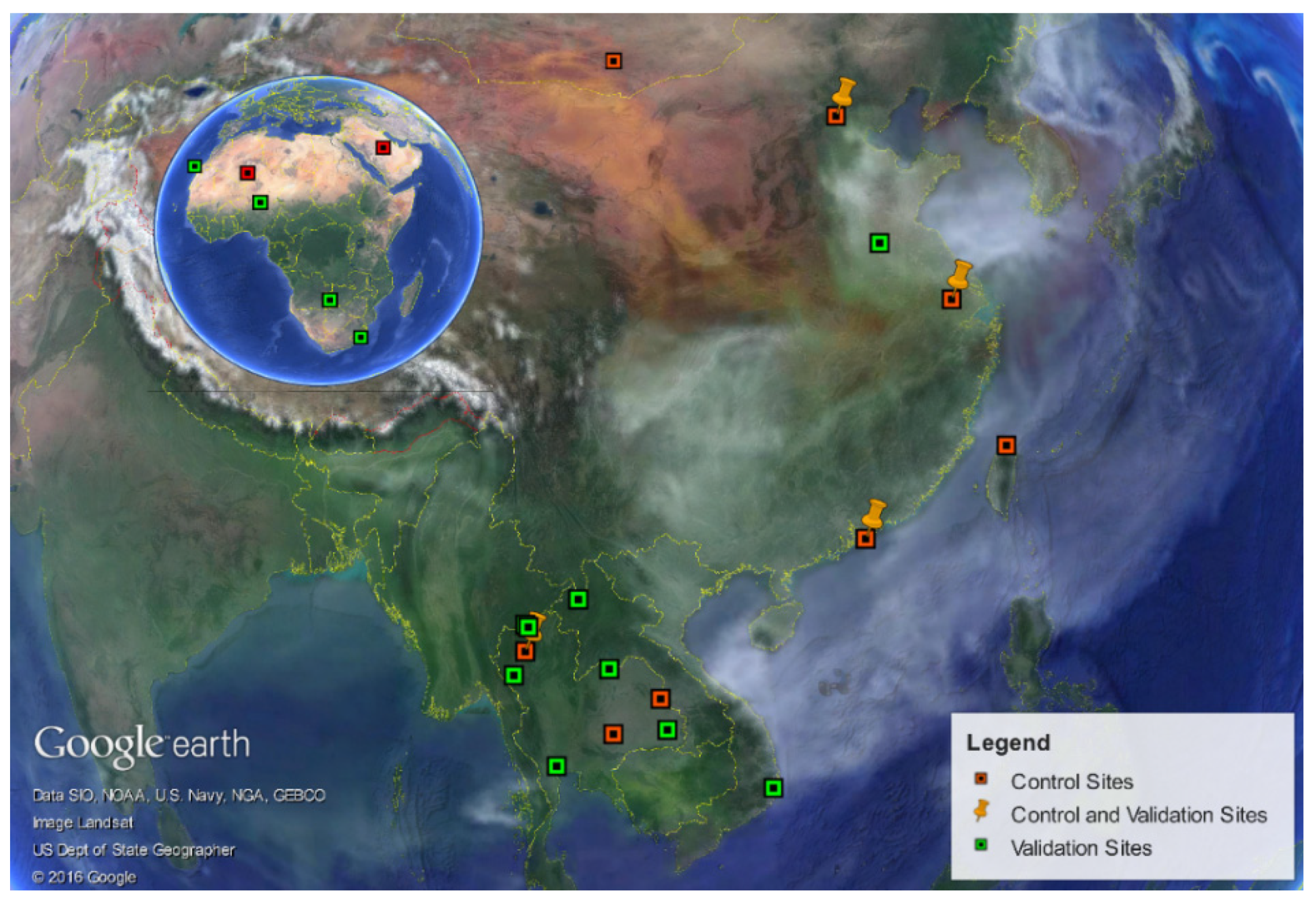
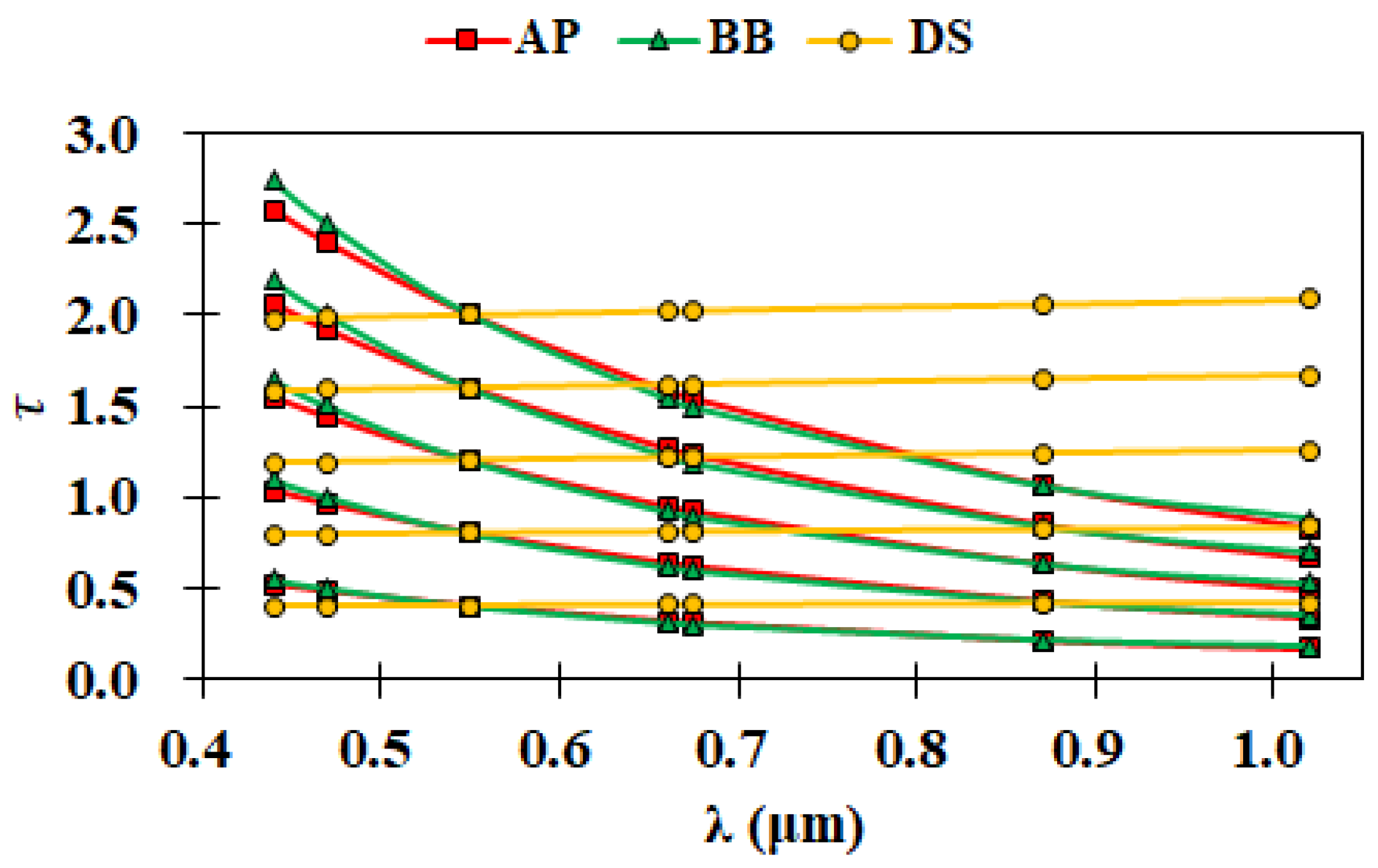

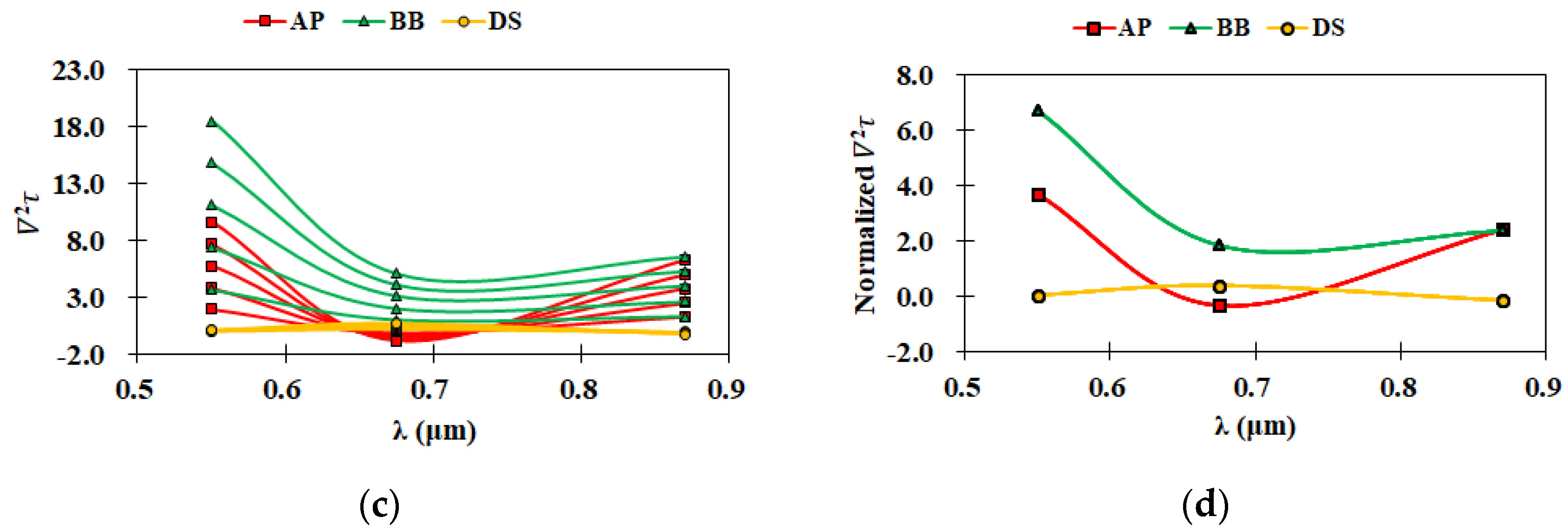
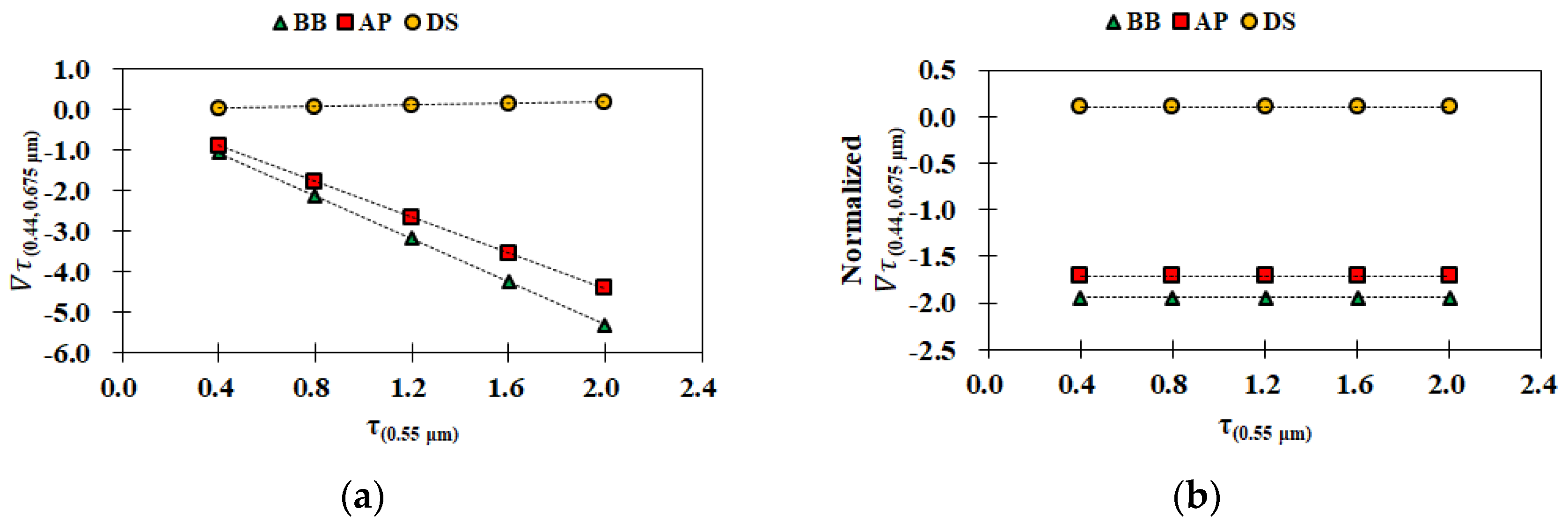
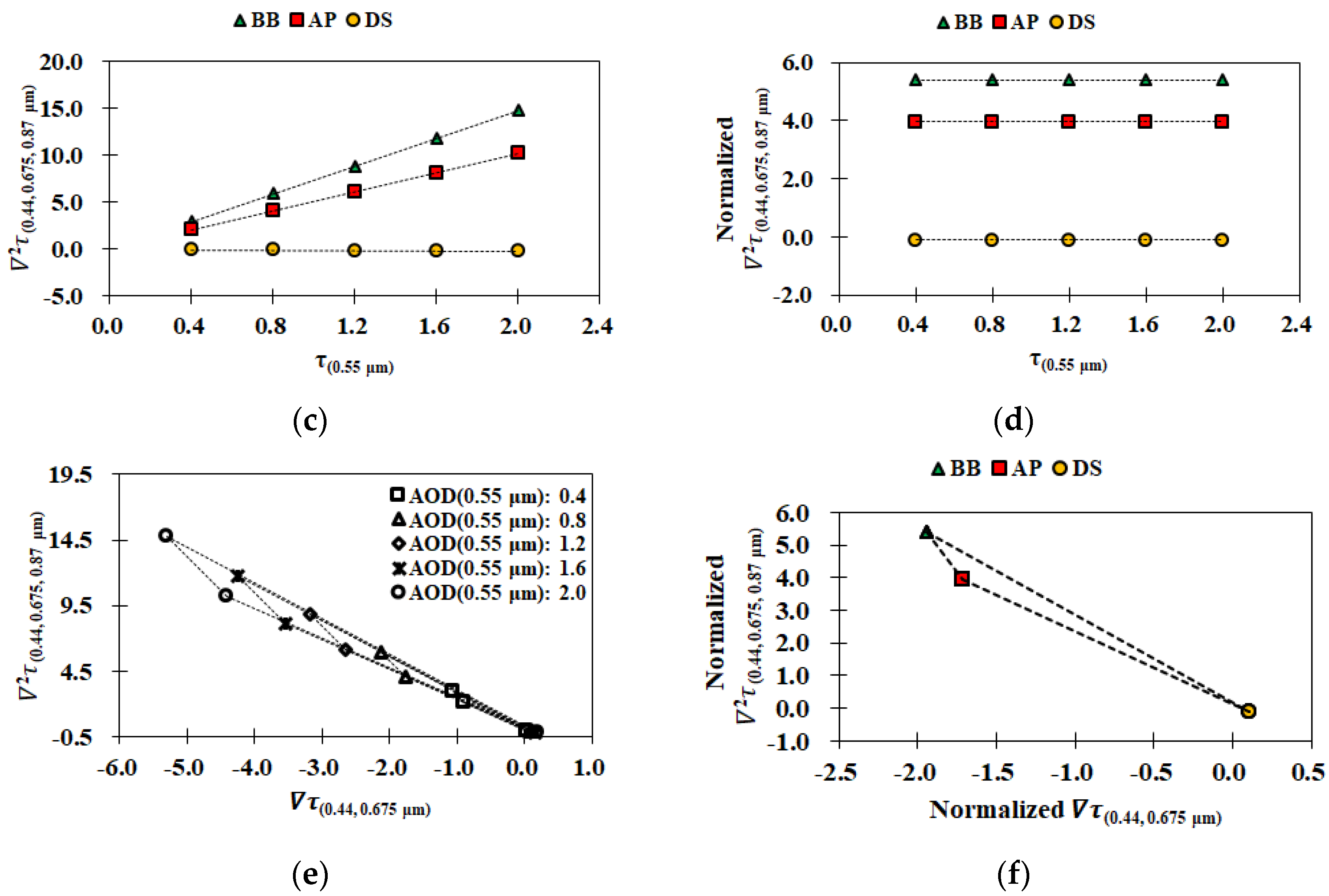

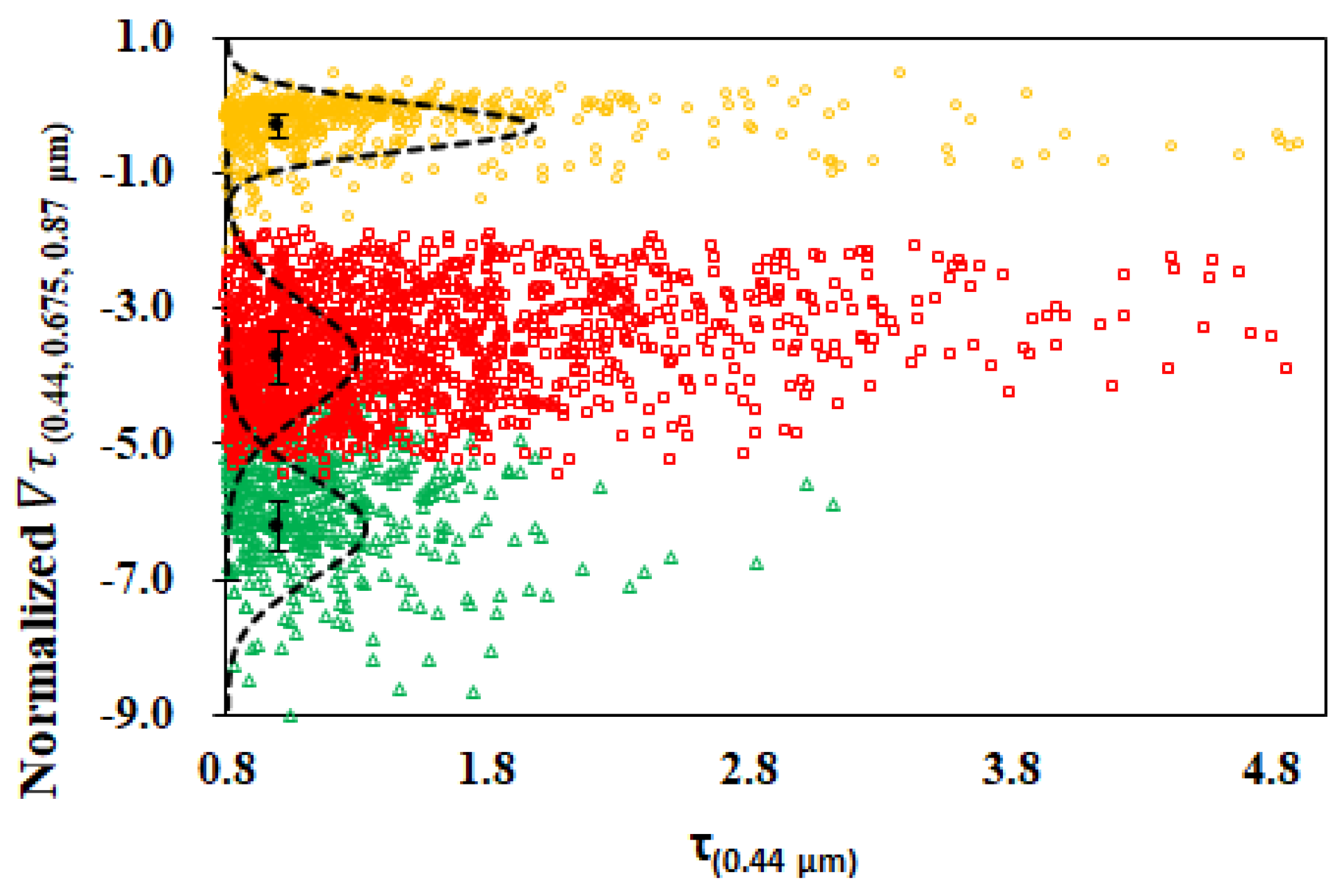
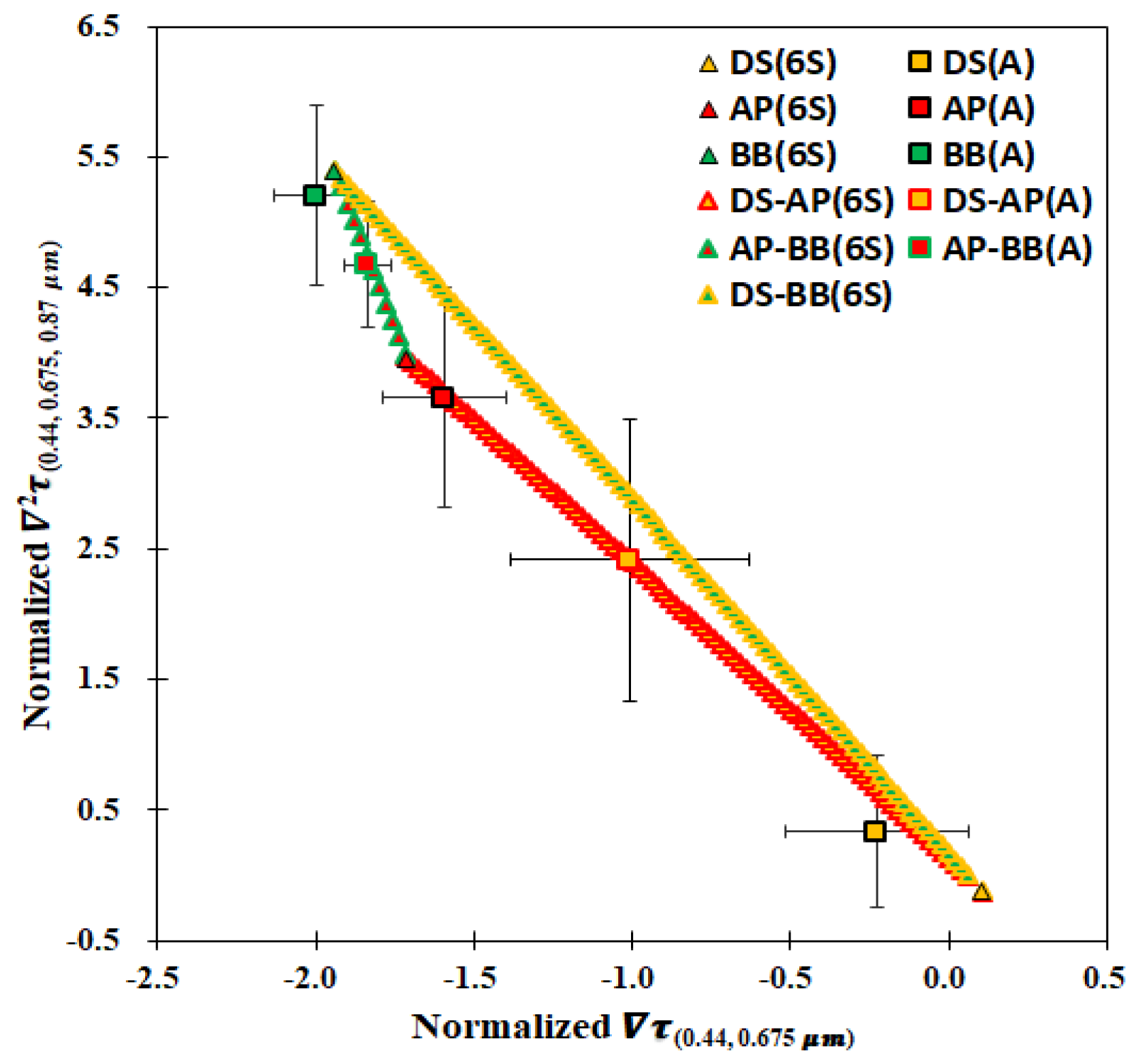

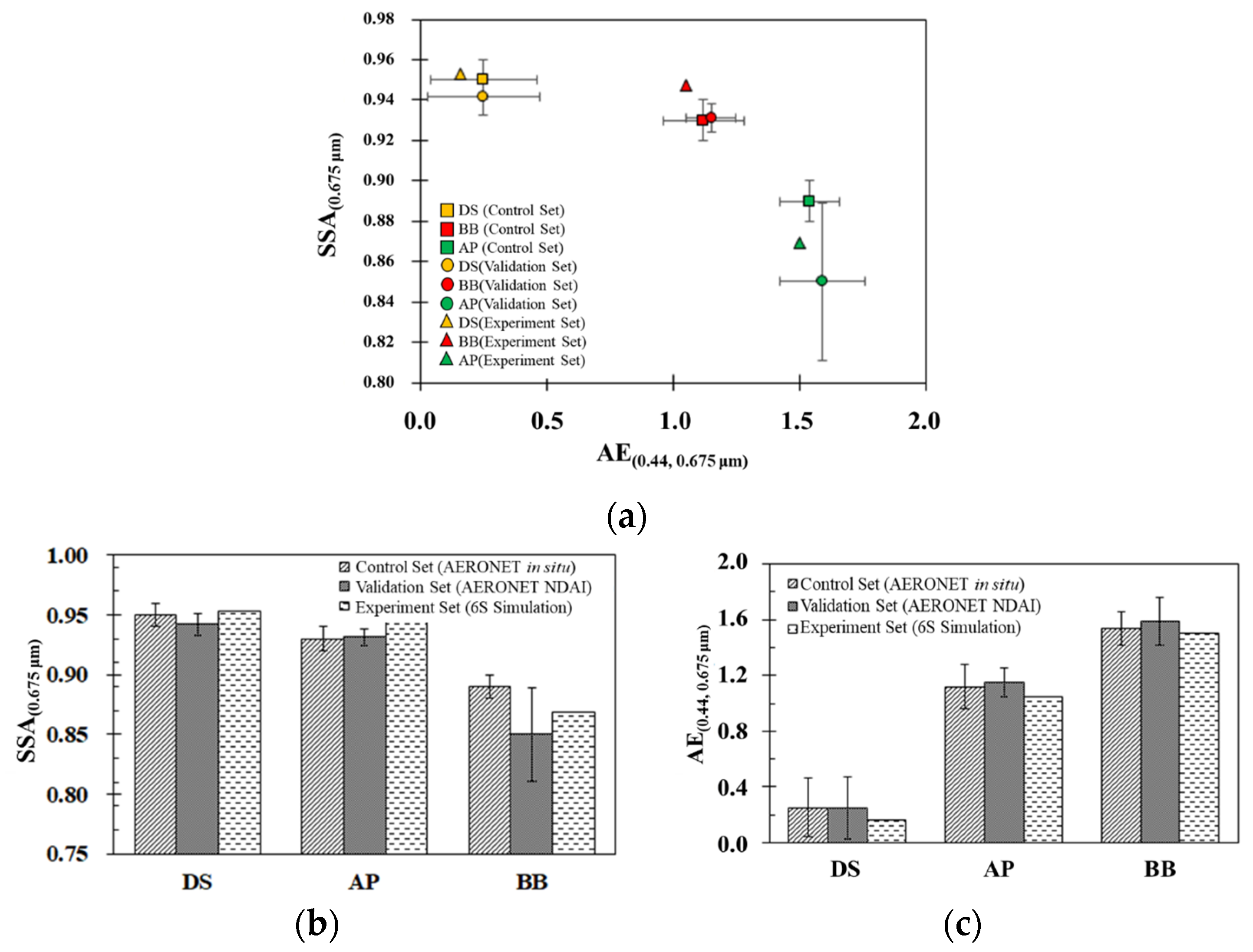
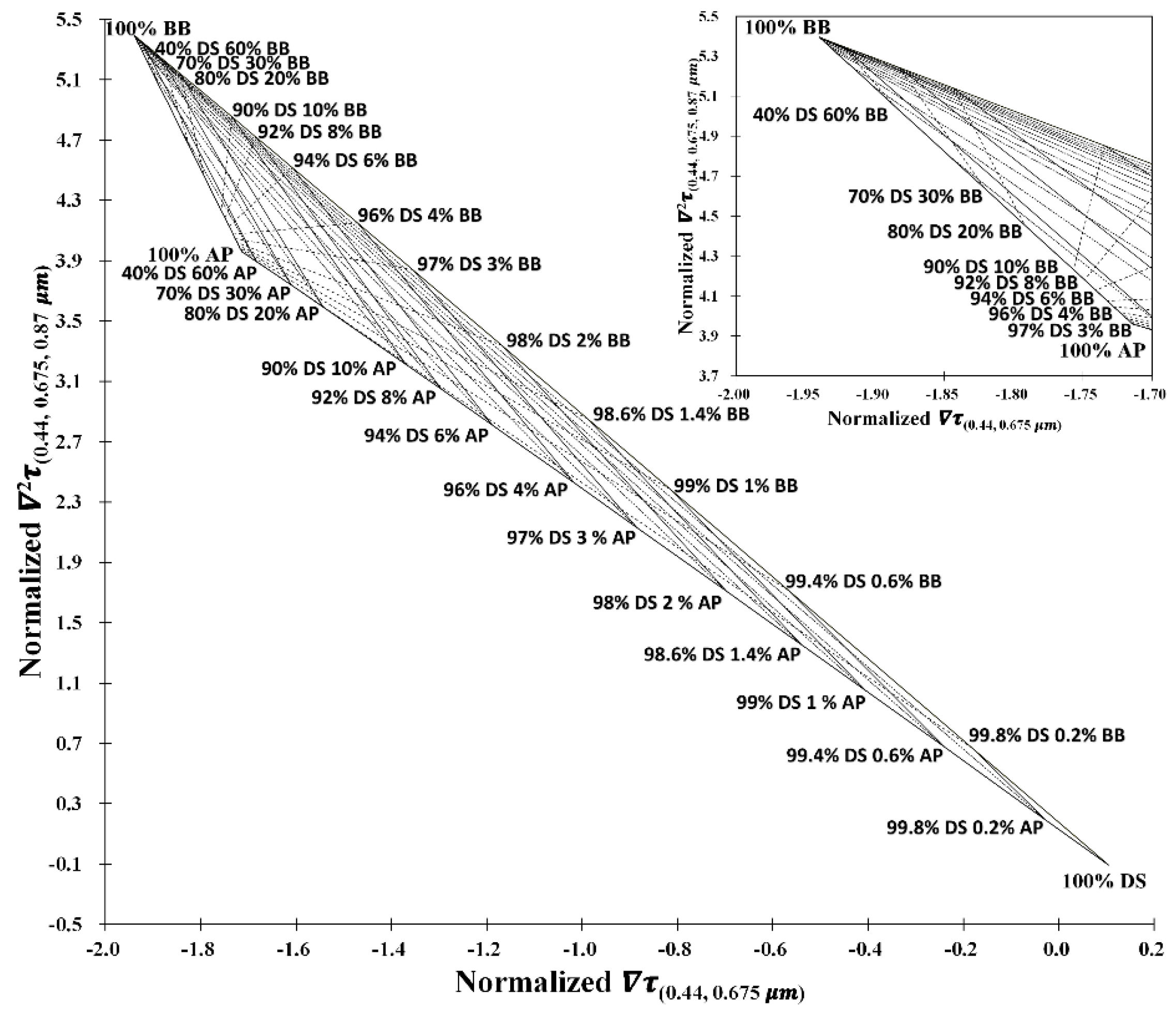
| λ (μm) | DS | AP | BB | |||
|---|---|---|---|---|---|---|
| nr | ni | nr | ni | nr | ni | |
| 0.400 | 1.53 | 8.00 × 10−3 | 1.53 | 5.00 × 10−3 | 1.75 | 0.46 |
| 0.488 | 1.53 | 8.00 × 10−3 | 1.53 | 5.00 × 10−3 | 1.75 | 0.45 |
| 0.515 | 1.53 | 8.00 × 10−3 | 1.53 | 5.00 × 10−3 | 1.75 | 0.45 |
| 0.550 | 1.53 | 8.00 × 10−3 | 1.53 | 6.00 × 10−3 | 1.75 | 0.44 |
| 0.633 | 1.53 | 8.00 × 10−3 | 1.53 | 6.00 × 10−3 | 1.75 | 0.43 |
| 0.694 | 1.53 | 8.00 × 10−3 | 1.53 | 7.00 × 10−3 | 1.75 | 0.43 |
| 0.860 | 1.52 | 8.00 × 10−3 | 1.52 | 1.20 × 10−3 | 1.75 | 0.43 |
| 1.536 | 1.4 | 8.00 × 10−3 | 1.51 | 2.30 × 10−3 | 1.77 | 0.46 |
| 2.250 | 1.22 | 9.00 × 10−3 | 1.42 | 1.00 × 10−3 | 1.81 | 0.50 |
| 3.750 | 1.27 | 1.10 × 10−2 | 1.452 | 4.00 × 10−3 | 1.90 | 0.57 |
| Rmean (μm) | 0.50 | 0.005 | 0.0118 | |||
| Rstd (σ) | 2.99 | 2.99 | 2.00 | |||
| Control dataset (for NDAI approach construction). | ||
| DS | BB | AP |
| April–May | March–May | August–September |
| Beijing (39N,116E) 2001–2012 | Chiang Mai (18N,98E) 2006–2012 | Beijing (39N,116E) 2001–2012 |
| Dalanzadgad (43N,104E) 1997–2012 | Mukdahan (16N,104E) 2003–2010 | Hong Kong (22N,114E) 2005–2012 |
| Solar Village (24N,46E) 1998–2012 | Pimai (15N,102E) 2003–2008 | Taihu (31N,120E) 2005–2012 |
| Tamanrasset (22N,5E) 2006–2012 | Taipei (25N,121E) 2002–2012 | |
| Validation dataset (for NDAI product validation) | ||
| DS | BB | AP |
| April–May(2014–2016) | March–May(2014–2016) | August–September(2014–2016) |
| Beijing (39N,116E) | Chiang Mai (18N,98E) | Beijing (39N,116E) |
| La Laguna (28N,16W) | Doi Ang Khang (19N,99E) | Durban UKZN (30S, 31 E) |
| XuZhou (34N,117E) | Luang Namtha (20N,101E) | Hong Kong (22N,114E) |
| Zinder Airport (14N, 9E) | Maeson (19N,99E) | La Laguna (28N,16W) |
| Mongu Inn (15S, 23E) | Mongu Inn (15S, 23E) | |
| NhaTrang (12N,109E) | Taihu (31N,120E) | |
| Omkoi (17N,98E) | Taipei (25N,121E) | |
| Silpakorn Univ (13N,100E) | XuZhou (34N,117E) | |
| Ubon Ratchathani (15N,104E) | ||
| Vientiane (17N,102E) | ||
| Data Source | Aerosol Intrinsic Property | DS (n = 205) | AP (n = 394) | BB (n = 85) |
|---|---|---|---|---|
| Instrument observation (AERONET) | AOD(0.44μm) | 1.24 ± 0.55 | 1.47 ± 0.66 | 1.33 ± 0.38 |
| AE(0.44, 0.675μm) | 0.25 ± 0.21 | 1.12 ± 0.16 | 1.54 ± 0.12 | |
| SSA(0.675μm) | 0.95 ± 0.01 | 0.93 ± 0.01 | 0.89 ± 0.01 | |
| NDAI(0.44, 0.675, τ(ref)=0.44μm) | −0.27 ± 0.26 | −1.62 ± 0.18 | −2.05 ± 0.11 | |
| NDAI(0.44, 0.675, τ(ref) = 0.675μm) | −0.31 ± 0.32 | −2.65 ± 0.46 | −3.98 ± 0.43 | |
| NDAI(0.44, 0.675, τ(ref)=0.87μm) | −0.33 ± 0.34 | −3.73 ± 0.80 | −6.22 ± 0.75 | |
| NDAI(0.44, 0.675, τ(ref)=1.02μm) | −0.35 ± 0.36 | −4.71 ± 1.14 | −8.60 ± 1.34 | |
| Theoretical simulation (6S model and experiment dataset) | AOD(0.44μm) | 1.19 ± 0.40 | 1.48 ± 0.49 | 1.64 ± 0.55 |
| AE(0.44, 0.675μm) | 0.16 | 1.05 | 1.50 | |
| SSA(0.675μm) | 0.95 | 0.95 | 0.87 | |
| NDAI(0.44, 0.675, τ(ref)=0.44μm) | −0.28 | −1.58 | −2.07 | |
| NDAI(0.44, 0.675, τ(ref)=0.675μm) | −0.30 | −2.81 | −4.39 | |
| NDAI(0.44, 0.675, τ(ref)=0.87μm) | −0.30 | −3.86 | −6.19 | |
| NDAI(0.44, 0.675, τ(ref)=1.02μm) | −0.30 | −4.84 | −7.48 |
Publisher’s Note: MDPI stays neutral with regard to jurisdictional claims in published maps and institutional affiliations. |
© 2021 by the authors. Licensee MDPI, Basel, Switzerland. This article is an open access article distributed under the terms and conditions of the Creative Commons Attribution (CC BY) license (https://creativecommons.org/licenses/by/4.0/).
Share and Cite
Lin, T.-H.; Tsay, S.-C.; Lien, W.-H.; Lin, N.-H.; Hsiao, T.-C. Spectral Derivatives of Optical Depth for Partitioning Aerosol Type and Loading. Remote Sens. 2021, 13, 1544. https://doi.org/10.3390/rs13081544
Lin T-H, Tsay S-C, Lien W-H, Lin N-H, Hsiao T-C. Spectral Derivatives of Optical Depth for Partitioning Aerosol Type and Loading. Remote Sensing. 2021; 13(8):1544. https://doi.org/10.3390/rs13081544
Chicago/Turabian StyleLin, Tang-Huang, Si-Chee Tsay, Wei-Hung Lien, Neng-Huei Lin, and Ta-Chih Hsiao. 2021. "Spectral Derivatives of Optical Depth for Partitioning Aerosol Type and Loading" Remote Sensing 13, no. 8: 1544. https://doi.org/10.3390/rs13081544
APA StyleLin, T.-H., Tsay, S.-C., Lien, W.-H., Lin, N.-H., & Hsiao, T.-C. (2021). Spectral Derivatives of Optical Depth for Partitioning Aerosol Type and Loading. Remote Sensing, 13(8), 1544. https://doi.org/10.3390/rs13081544







